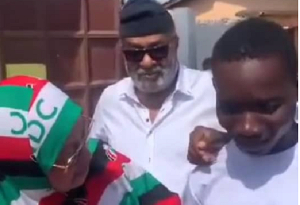The joint venture partnership between the Government of Ghana and the Government of India towards reviving the Komenda Sugar factory is a highly risky one, which could be counterproductive, the Convention People’s Party’s Political Affairs Director Ekow Duncan has said.
“The Komenda that you have put in place is the same structure as Aveyime Rice: Indian Exim loan, Indian Management; you run a very serious risk by having such an investment.
“You know what the Indians can possibly do?...They will at one stage spend the money, abandon the project and go away and the liability will be [for the] Ghana Government,” Mr Duncan told Morning Starr’s Kafui Dey on Starr 103.5FM Friday.
The Indian Government is bearing $35 million dollars of the $36.5 million joint venture project meant to revive the defunct factory.
Ghanaian Think-tank, IMANI, in August last year said the government of Ghana needed a minimum of $90 million dollars to revive the factory.
President John Mahama broke ground for the factory’s reconstruction last year.
The dormant factory was constructed by the Nkrumah administration five decades ago and collapsed in the 80s.
The 125-tonne capacity factory–which is expected to process some 1,250 sugarcanes regularly–is projected to create about 1,300 direct jobs for industrial workers and smallholder farmers, as well as spawn an additional 5,000 indirect jobs.
However, IMANI Ghana, in its advisory warned that lack of funding is likely to be one of five risks that could work against the factory’s revival.
“The $36m sourced for the project is completely unrealistic and will lead to commissioning challenges down the line," IMANI predicted.
“Since the early 70s, several feasibility studies have been carried out, notably by the World Bank, and the expert consensus is that it will take about $90m minimum to do a good job of bringing the factory and plantation/out-grower scheme up to scratch," the think tank said.
The advisory, signed by IMANI President Franklin Cudjoe wondered where and how the Ghanaian government will raise the balance to ensure the project is successfully undertaken.
“…As it stands now, the project is under-capitalised, so government needs to start looking for more resources," the advisory noted.
Also, the group said: “It will take no less than 1000 hectares of land to produce enough sugarcane to even begin to make this viable. In fact, using standard yields suggest a requirement for more than 7000 hectares to meet the planned throughput of the factory. This is significantly higher than the proven arable land available in the project catchment area.
“Given the irrigation and husbandry challenges in the area, and the significant deterioration of the water profile and soil quality over time, significant time, skills, and resources are needed to bring the agricultural potential of the area up to par. Even in the best of time, sugarcane rarely takes less than a year to be ready for harvest. Without a significant ramp-up in efforts, it is unlikely that Komenda or Asutuare can ever produce enough sugarcane to feed the plant.
“There has to be a contingency plan involving either the import of raw sugar for refining since sourcing of sugarcane from Latin America may prove expensive due to shipping and logistics costs. But if that were ever to be required, the storage implications need to be assessed well in advance,” IMANI said.
It also mentioned that: “At current sugar prices, the gross sales projections of $20 million a year are over-optimistic. Clearly the investors are justifying the under-capitalisation of the business by inflating the cash flow expectations."
“A superior marketing plan is required to dispose of 46,000 tonnes of sugar per year than has so far been produced," it advised.
Business News of Friday, 27 March 2015
Source: starrfmonline.com

















